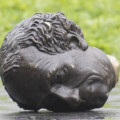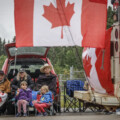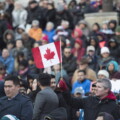Editor’s note: We are delighted at The Hub to be the venue for Aiden Muscovitch’s first-ever published piece of analysis, which we expect will be the first of many. Aiden joined us as a co-op student because he enjoyed the analysis and debate at The Hub and he quickly realized that this spirit was lacking in his high school. Please enjoy Aiden’s engaging plea for a broader and more inclusive debate for our young people.
One morning, as I checked my phone, I got a Facebook notification. “6 Years Ago-With Zak Muscovitch.” I opened the notification and saw this photo of me and my dad outside of Roy Thomson Hall attending a Munk Debates event. It sparked so many memories.
This was not a regular debate; this was the 2015 Federal Election Debate on Canadian foreign policy. Incumbent Prime Minister Stephen Harper, former NDP Leader Thomas Mulcair, and then up-and-coming Liberal Leader Justin Trudeau were battling it out. Even as a ten-year-old kid, barely grasping the Canadian electoral system or foreign policy, I loved it.
When the debate wrapped up, my Dad and I walked out of the auditorium and into the lobby. An audience member came up to us and said, “I would never bring a kid to something like this,” in a harsh, disapproving voice and walked away. I was upset because I thought that I embarrassed my Dad in front of all these people, and I felt disappointed in myself for coming to the debate in the first place.
The thought that young people should not be exposed to certain topics because it’s deemed to be too “problematic” is becoming a widespread ideology. That audience member felt that I did not belong, that I should not have been in a space where such robust debate was taking place. She did not want me to hear these ideas and she did not want me to develop my own opinions. School boards all over Canada are following the same regressive path, with even steeper consequences for the students.
Diversity of thought can only be achieved by example. Youth all over Canada are being hidden from points of view that others think they may not comprehend. This is shown recently as Marie Henein’s book was not allowedMarie Henein speaks out about ‘outrageous’ disinvitations. https://thehub.ca/2021-11-16/marie-henein-speaks-out-about-outrageous-disinvitation/ to be read in the A Room of Your Own Book Club, which holds its events in schools belonging to multiple school boards, while teachers and principals promote them. This book club is meant for teenage girls to hear from female authors. Tanya Lee, the organizer of the A Room of Your Own Book Club, reported that a TDSB Superintendent told her that Henein’s event would not be promoted in TDSB schools because Henein defended Jian Ghomeshi, asking “how do you explain that to little girls?”Toronto school board rejects Marie Henein book club event. https://www.theglobeandmail.com/canada/article-tdsb-students-wont-be-attending-marie-henein-book-club-event-amid/
Nobel Peace Prize Laureate Nadia Murad had an uncannily similar issue with the TDSB. Murad was invited to speak at the same book club as Henein. The TDSB Superintendent also told Lee that students would not be allowed to participate in an event with Murad. Lee said she was told Murad’s book, The Last Girl: My Story of Captivity, and My Fight Against the Islamic State, would promote IslamophobiaCanadian schools ban a Nobel Laureate to avoid looking ‘Islamophobic.’ https://nationalpost.com/news/canada/first-reading-canadian-schools-ban-a-nobel-laureate-to-avoid-looking-islamophobic. Not only does this stop students from hearing another side to an incredibly complex story, but it sets a precedent for all students to not speak up about any form of injustice from their perspective.
After hearing the stories of Marie Henein and Nadia Murad, I understand that without debate and the freedom to discuss big, new, unconventional ideas and current issues, whole generations would be kept from other viewpoints that may differ from their own, and it is happening to our students now. This act of withholding information from our students will lead them to become sheep, following the wicked crook of their close-minded shepherd. In both Marie Henein and Nadia Murad’s cases, the shepherd is the TDSB.
Students have been guided by our teacher’s own worldview, and at times, ignorance with the stick instead of the carrot. As students, we feel as if we cannot object to the teacher’s point of view. The power imbalance is so vast that when we try to push back on the teacher’s assertions with our own thoughts and/or life experiences, we are ignored. We are forced to bite our tongues and keep our hands down, and if we choose not to, we are ostracized.
In Henein’s Dialogue with The Hub, she stated, “First of all, it infantilizes everybody. We aren’t triggered constantly; we aren’t falling or passing out every time someone says something that we don’t agree with. We can sustain conversation and we can withstand opposite views.” The flawed ideology of sheltering students from opinions the administrators of school boards may find dangerous or problematic will be detrimental to future generations. Both the TDSB Superintendent and the audience member at the Munk Debates have participated in the growing indoctrination that silencing students and preventing them from hearing bold opinions, perspectives, ideas, and schools of thought is beneficial for their students. It most certainly is not.
A recent Intelligent study that interviewed conservative, liberal, and moderate university students, asked the students how frequently they withhold their opinions or perspectives in the classroom and what are the fears behind the decisions to withhold their point of view. The top three fears among conservative students are losing their professors’ respect (40 percent), losing their classmates’ respect (40 percent), and jeopardizing their grades (39 percent). For liberal students, their top three concerns are losing their classmates’ respect (37 percent), being ridiculed or confronted (37 percent), and putting their physical safety at risk (35 percent). The top three concerns among moderate students are losing their classmates’ respect (37 percent), being ridiculed or confronted (37 percent), and jeopardizing their grades (35 percent).
Fifty-five percent of conservative students, 52 percent of moderate students, and 49 percent of liberal students say they “always” or “often” refrain from speaking up about political or social issues in the classroom out of concern for potential consequences. Withholding speech is becoming an epidemic that affects all students, no matter their political affiliation“Many students simply have no idea how to disagree constructively, or even if constructive disagreement is possible,” said James Patterson, Associate Professor of Politics at Ave Maria University. https://universitybusiness.com/the-3-reasons-why-students-dont-want-to-share-political-views-in-class/.
Teachers tell their students that the classroom is an open environment to express themselves freely. They will not mention that if they do, they face a plethora of both discrete punishments and not-so-discrete public humiliation, done by the teacher, of course. Most of the argumentative scenarios I have seen are not amongst students; the teacher starts and finishes the tensest dialogues in the classroom. I assure you that they are not playing the Devil’s Advocate. They really, truly mean what they are saying and are more than happy to strike down any conflicting opinions.
I have had teachers give hour-long lectures on why being uncomfortable in the classroom is beneficial. Yet in those very same lectures, if one brave soul decides to speak up, the teacher becomes absolutely perplexed by the idea that somebody might actually disagree with them.
Of course, not all teachers are like this. I have had some teachers that promote free speech and implement it in their classes. But, I feel that it is a rarity. It has been an extremely infrequent occurrence in my high school career where the teacher has told their students the facts on any given subject and allowed them to formulate their own opinions.
We have a brilliant but silent minority of students from all walks of life that possess different viewpoints and experiences and who look into these issues for themselves. They will dive deep into these social problems and establish an opinion.
The reason why this is a minority of students rather than a majority is that students are generally too timid to break the mould. We grow up idolizing our teachers, valuing what they have to say. That never stops until students identify what they may or may not disagree with. Lots of students are not at the point when they can make that distinction for themselves so they follow what the teacher says. Instead, teachers should be encouraging their students to look for themselves to develop their own opinions.
To remedy this issue, there are a few viable options. We must have teachers that do not project their opinions but give their students unbiased information to make their own. This calls for total educational reform involving student-teacher-administration transparency policies and a refreshed curriculum that allows all students to speak freely and not be docked grade points for doing so. There should be reviews by the administration on how teachers prepare their lesson plans and how they acquire the information to prepare them. There must be policy changes within school boards and private institutions that would enable students to feel comfortable in expressing their views freely. We need to convert our concern into action before future generations turn into mindless lemmings.
With that being said, nothing in life is neutral. The classroom should be fueled with discussions about all sorts of controversial topics, but all voices need to be valued or at least heard. There are going to be ill-advised opinions, offensive ones. Still, when they do come up, teachers should use this as a teachable moment to address why it may be ill-advised or offensive but not crucify their students due to their ignorance. A teacher’s job is to educate, not humiliate. In a democratic society and in a classroom that moulds the brains of the inhabitants of such a society, open discussion on various topics is crucial, especially to students today who will be tomorrow’s adults.
Recommended for You

Christopher Snook: Is Canada sleepwalking into dystopia?

Ginny Roth: How vacant liberal nationalism left Canada worse off than George Grant even imagined

Michael Kaumeyer: Polite decline: Canada’s aversion to being our best is holding us back

Howard Anglin: Lament for a Lament




